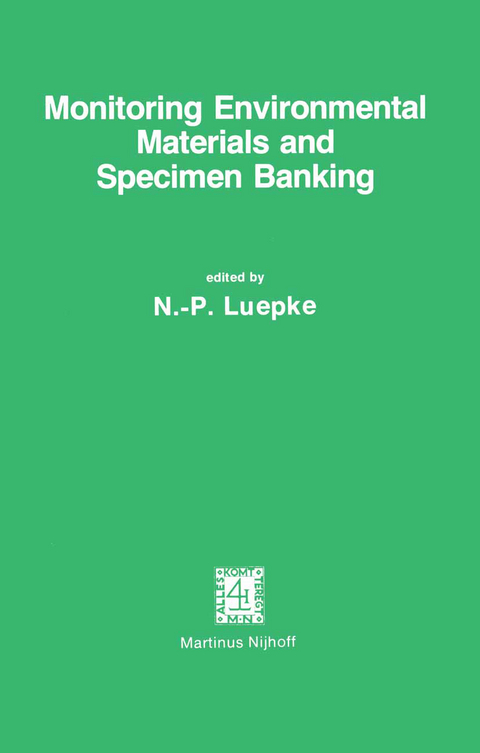
Monitoring Environmental Materials and Specimen Banking
Springer (Verlag)
978-94-009-8845-3 (ISBN)
Conclusions and Recommendations.- I. Introduction.- 1. Terminology and definitions.- 2. Objectives of the workshop and the final document.- 3. Monitoring environmental materials.- 4. Specimen banking.- II. Selection of Pollutants and Pollutant Categories of Interest for Monitoring Environmental Materials.- III. Selection of Environmental Materials Related to Ecosystems and Pollutants or Pollutant Categories.- 1. General aspects.- 2. Review of past and current programmes.- 3. Criteria for the selection of ecosystem compartments and processes.- IV. Technical Considerations.- 1. General remarks.- 2. Collection, collection equipment, sample preparation and transportation.- 3. Container materials.- 4. Storage methods.- 5. Conclusions and recommendations.- V. Analytical Aspects.- 1. Analytical methods.- 2. Profile and fingerprint methods.- 3. Partly of fully automatized analysis.- 4. Standardisation and quality control.- VI. Programme Design and Organizational Aspects.- 1. Goal and objectives.- 2. Statistical and biomathematical requirements.- 3. General guidelines.- 4. Recommendations for further research.- VII. Cost Estimation.- 1. Monitoring environmental materials.- 2. Specimen banking.- 3. Conclusions.- VIII. Ethical and Legal Considerations.- Annex I.- Abstracts of working papers.- Annex II.- Working papers submitted for the Workshop.- Monitoring inorganic pollutants in domestic and farm animals.- Monitoring environmental materials and specimen banking using terrestrial insects with particular reference to inorganic substances and pesticides.- Use of oysters and related molluscs as biological monitors of synthetic organic pollutants.- Specimen banking marine organisms.- Advantage and problems of usung wild-living animals as indicators for environmental pollution.- Naturally occuring steroids and synthetic hormones as sensitive monitoring compounds for the suitability of pretreatment procedures in specimen banking and for the long-term stability of stored biological samples.- Container materials for the preservation of trace substances in environmental specimens.- Monitoring of plants and soil for analysis of possible hazardous contaminants and banking of these environmental specimens.- Non-halogenated organic compounds in aquatic and terrestrial ecosystems.- Organic and inorganic compounds — analytical aspects.- Use of macroalgae as a reference material for pollutant monitoring and specimen banking.- A comparative analysis among responses to acute toxicity in standard laboratory bioassays and in natural streams.- Specimen bank research at the National Bureau of Standards to insure proper scientific protocols for the sampling, storage and analysis of environmental materials.- Monitoring environmental materials and specimen banking — state-of-the-art of Japanese experience and knowledge.- Organo-halogenated compounds in aquatic ecosystems.- Statement of polycyclic aromatic hydrocarbons.- Organo-halogenated compounds in farm and domestic animals.- Monitoring environmental materials and specimen banking for organohalogenated compounds in aquatic ecosystems.- Experiences in monitoring and banking human biological specimen.- Organohalogenated compounds in plants and soil.- Terrestrial vertebrate animals as biological monitors of pollution.- The mussel watch biological monitoring research program.- Collection, storage and analysis of freshwater fish for monitoring environmental contaminants.- State-of-the-art of biological specimen banking in the Federal Republic of Germany.- Ecological action of mercury by-products on different animaltissues.- Organo-halogenated compounds in terrestrial wildlife.- Basic ecological concepts and urban ecological systems.- Considerations applicable to the monitoring of organohalogenated compounds in terrestrial wildlife, especially birds.- The role of deep-sea organisms in monitoring environmental xenobiotics.- The grey mullet (Mugil cephalus L.) as a marine bioindicator.- Archiving wildlife specimens for future analysis.- Trace metals in living marine resources taken from north atlantic waters.- Some U.S. legal concerns in obtaining, archiving, and using non-human tissue samples.- Pollution effects in freshwater communities.- The use of fishes in the monitoring environmental materials and specimen banking.- Monitoring serial inorganic pollutants by plant indicator specimens.- Choice of species, sampling and sample pretreatment for subsequent analysis and banking of marine organisms useful for Hg, Pb and Cd monitoring.- Specimen banking of food samples for long term monitoring of nutrient trace elements.- Annex III.- List of contributors and participants.
| Zusatzinfo | 606 p. |
|---|---|
| Verlagsort | Dordrecht |
| Sprache | englisch |
| Maße | 155 x 235 mm |
| Themenwelt | Medizin / Pharmazie ► Gesundheitswesen |
| Medizin / Pharmazie ► Medizinische Fachgebiete ► Pharmakologie / Pharmakotherapie | |
| Medizin / Pharmazie ► Pharmazie | |
| Studium ► Querschnittsbereiche ► Prävention / Gesundheitsförderung | |
| Technik ► Umwelttechnik / Biotechnologie | |
| ISBN-10 | 94-009-8845-1 / 9400988451 |
| ISBN-13 | 978-94-009-8845-3 / 9789400988453 |
| Zustand | Neuware |
| Haben Sie eine Frage zum Produkt? |
aus dem Bereich


